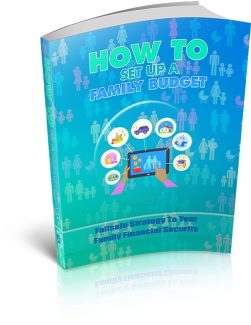 License Type: Private Label Rights
License Type: Private Label Rights  File Type: ZIP
File Type: ZIP
 SKU: 64606
SKU: 64606  Shipping: Online Download
Shipping: Online Download
Sample Content Preview
INTRODUCTION
"The average family exists only on paper and its average budget is a fiction, invented by statisticians for the convenience of statisticians."
Sylvia Porter
Unlike the quote provided above, seemingly reflective of general opinion on family budgets today, we will attempt to take a much more positive approach to budgeting, as a family oriented, user-friendly, financial management and planning tool and life-enabler.
However, when reflecting on family budgeting and inquiring as to why not more families are actually using it, it becomes self-evident that similar skepticism runs rampant and deep in reality and society, even globally so.
Once you start probing family budgets, expending time and energy researching the subject in-depth, it becomes quite clear, that most families are caught in a vicious, almost never-ending cycle of “What comes in must go out.”
Most families might feel that budgeting is a futile effort, unnecessarily burdening them with thoughts and ways, to go broke methodically and slowly, without the creature comforts and indulgences of our human modern-day society.
Others might voice that they feel as if they are merely throwing money away, in a never-ending and dizzying spiral of spend, spend, spend. People are getting deeper and deeper into debt, no matter how hard they try to get out of it. Questions are then raised: How do we stop these courses of action? How do we change the thinking around family fiscal discipline?
Put simply, in “How to set up a Family Budget”, we focus in on how to empower families to set up better, more realistic budgets, stick to them and celebrate their successes (and learn from their failures!)
Families eventually do have a monthly surplus, see their savings start to grow, consolidate their debt, set aside discretionary funds and personal allowances, build their wealth and become more aware of their pro-active involvement and responsibility regarding their lives and finances. This is when excitement builds and fundamental thought patters as well as spending attitudes are changed.
Budgeting is seen as an accurate measurement of success when significant behavioral transformation is taking place on the landscape of the family budget, spending habits and financial patterns we observe over time!
Do you ever feel that you do not have enough cash at the end of the month to pay bills, buy necessities of life? Are you barely making a dent in your credit card debt balance, no matter how hard you try?
Here is a reality check for all of us: if we choose to spend it, it is gone for good. We cannot spend it on anything else. Are you perhaps worried about a nest egg for your golden years or savings for early retirement? Then you have arrived at a source that can provide some prudent tips on how to start, finish, implement, stick to, revise and refine a family budget.
The family budget is a dynamic process, even more so than a mere static work-product, result, process-outcome or document. It will, can and should change over time. It becomes a barometer of a family?s fiscal circumstance, resources and health.
Maybe budgeting is not as much about reflecting on what you cannot have, but more about thoughts on how to stretch, invest and spend your earned dollars more wisely. In short, it is about making your money going further.
This quick-reference how-to guide was developed to assist you with setting up your own personal, household and family budget, to help you with all of the above and more!
A couple of general money-savings will also be provided in these pages. There are also thoughts and spending patterns that need to change, in order to become fiscally more disciplined and many techniques, attitudes, habitual behaviors that we need to un-earth, evaluate and possibly change, before you even start budgeting.
For example, being a bargain hunter looking for good buys, cutting down on careless spending, being on the lookout for careless credit card spending and letting the person who handles money best in your household actually take care of it, are all good examples of what we mean.
For most households, a budget is no more than a spending plan. Any spending plan can help you see where your money is going. It fits your spending to your income. It reflects how we get the things we want and need most, while being ready and prepared for bills we must pay every month.
For most families it is simply about making a budget you can live with and stick to easily. It is not a difficult exercise, but one most people fear, avoid or dread because of the unknown and perceived complexity of it (sometimes wrongfully so!).
Part of the goal of this guide is to demystify family budgeting and highlight an easy systematic process to setting up a quality family budget.
Many things actually drive our expenditure. We choose to spend our money on things we value, need, prefer or consciously choose. For some it is clothes, for others it might be something as simple as taking that yearly vacation.
- License: Private Label Rights
- Category:Ebooks
- Tags:2022 Ebooks Private Label Rights








